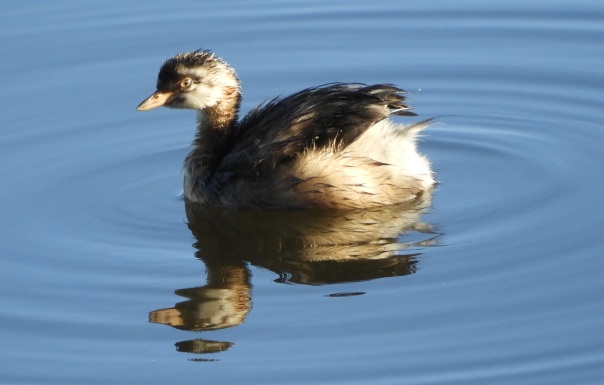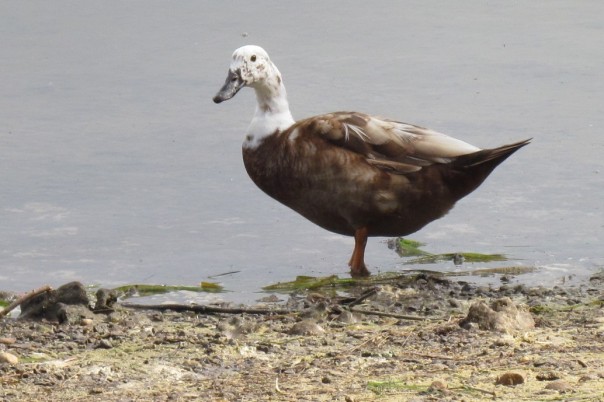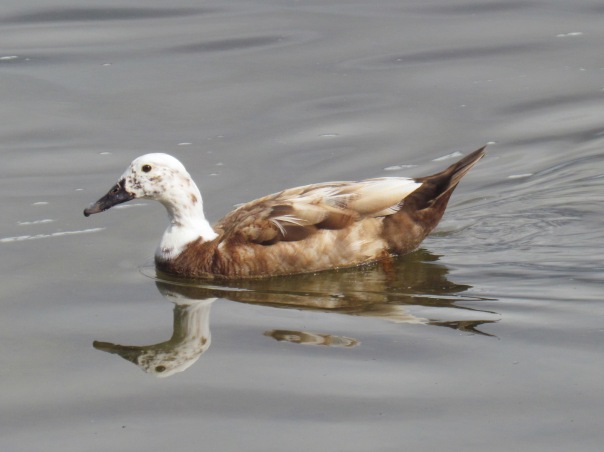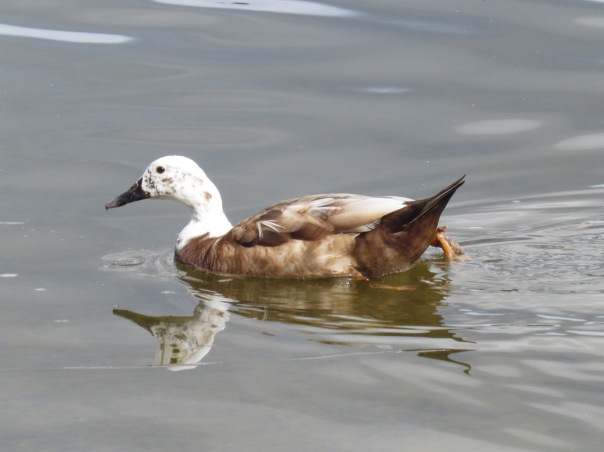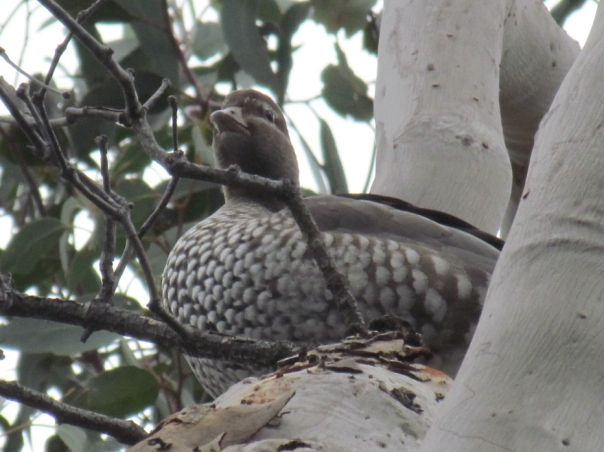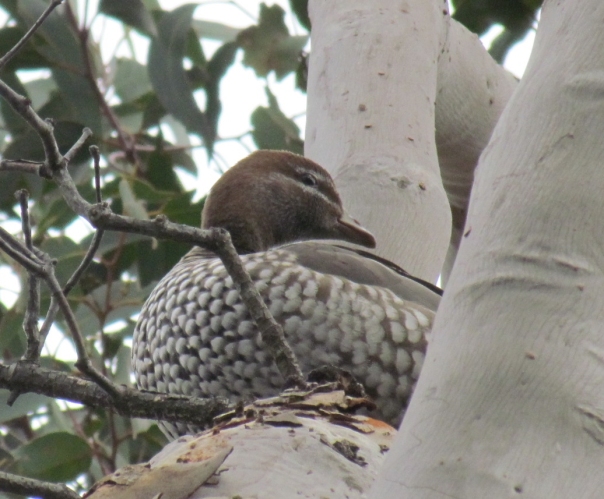Category Archives: Duck
Muscovy ducks meet a Brush-turkey
Two Muscovy ducks hiss and wag their tails to warn off an Australian Brush-turkey. The Brush-turkey had been investigating my shoes, then it decided to see what the two interesting ducks were up to. The encounter ends peacefully. No feathers flying this time!
Muscovy ducks come from the Americas, and are actually more like a cross between a goose and a duck than just a duck. They hiss like geese, although it’s a very quiet hiss. Their faces and heads look like geese, but their body shape is more like a duck’s.
I’ve seen this pair of Muscovies at Manly Dam often — they’ve made this area their home.
Common name: Australian Brush-turkey and Muscovy duck
Scientific name: Alectura lathami (Brush-turkey) and Cairina moschata (Muscovy)
Approximate length: 60-70 cm (Brush-turkey) and 76–84 cm (Muscovy)
Date spotted: 29 April 2025 (autumn)
Location: Manly Dam park, New South Wales, Australia: 33°46’44.9″S 151°14’58.4″E
Angry duck
This male Hardhead (on the right of the picture) looks like he has something to say. To his left, a Pacific Black Duck seems mildly surprised, or perhaps just living up to his scientific name, Anas superciliosa.

And perhaps the Hardhead thinks that his mate is paying too much attention to his supercilious rival!
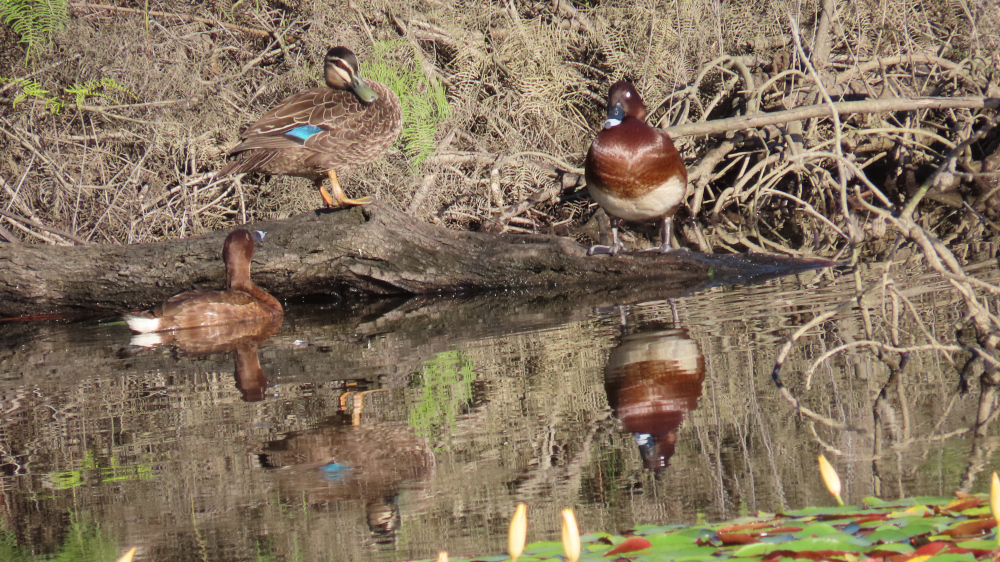
This is the first time I’ve photographed a Hardhead. Evidently they’re the only Australian duck that can claim the name of true diving ducks, as they dive deep into the water to feed. The males have white eyes while the females have brown eyes.
Common names: Hardhead and Pacific Black Duck
Scientific names: Aythya australis and Anas superciliosa
Approximate length: 45-60 cm and 48-60 cm
Date spotted: 2 December 2024 (summer)
Location: Manly Dam National Reserve, near Sydney, Australia: 33°46’34.8″S 151°14’49.6″E
The quiet of the duck
It’s early morning on New Year’s Day in the park. The air is still, the crowds haven’t yet arrived. The ducks putter around as only ducks can do.
I’m at Manly Dam park near Sydney. On a quiet morning, the dam water reflects the hills and forest all round. The oranges, browns, and reds in this scene aren’t seasonal, though they do bring autumn to mind. They show the path of a recent fire — a hazard reduction burn conducted to reduce the risk of more damaging fires as summer draws on.
Among the ducks were this Pacific Black Duck:
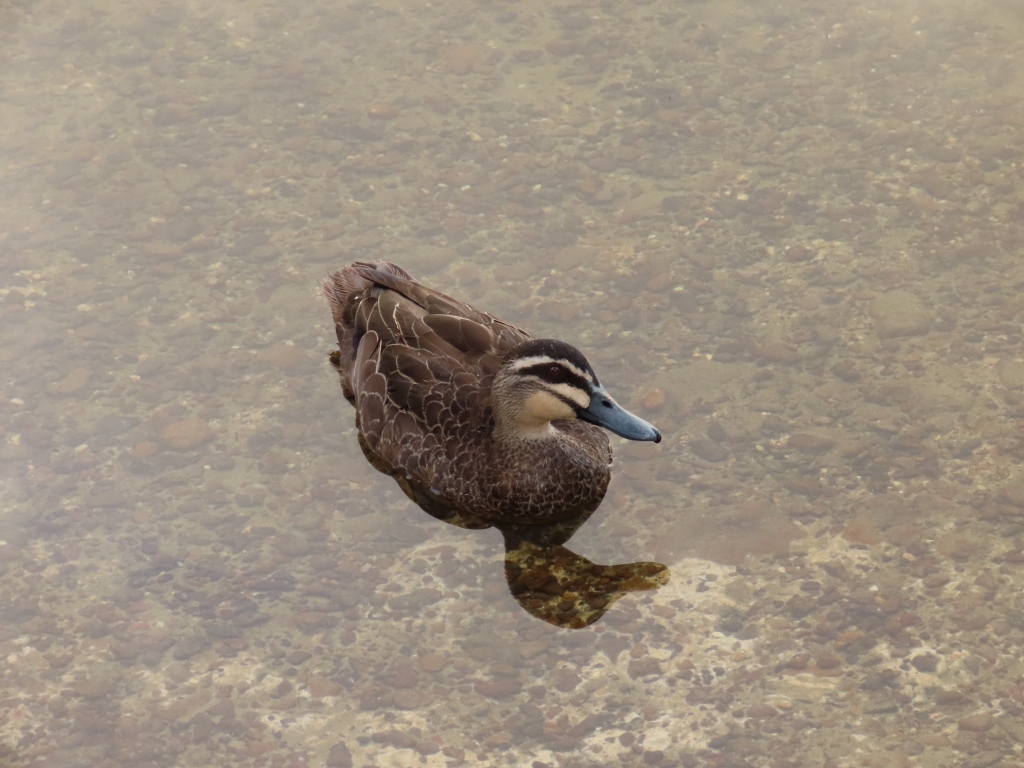
A male Australian Wood Duck:
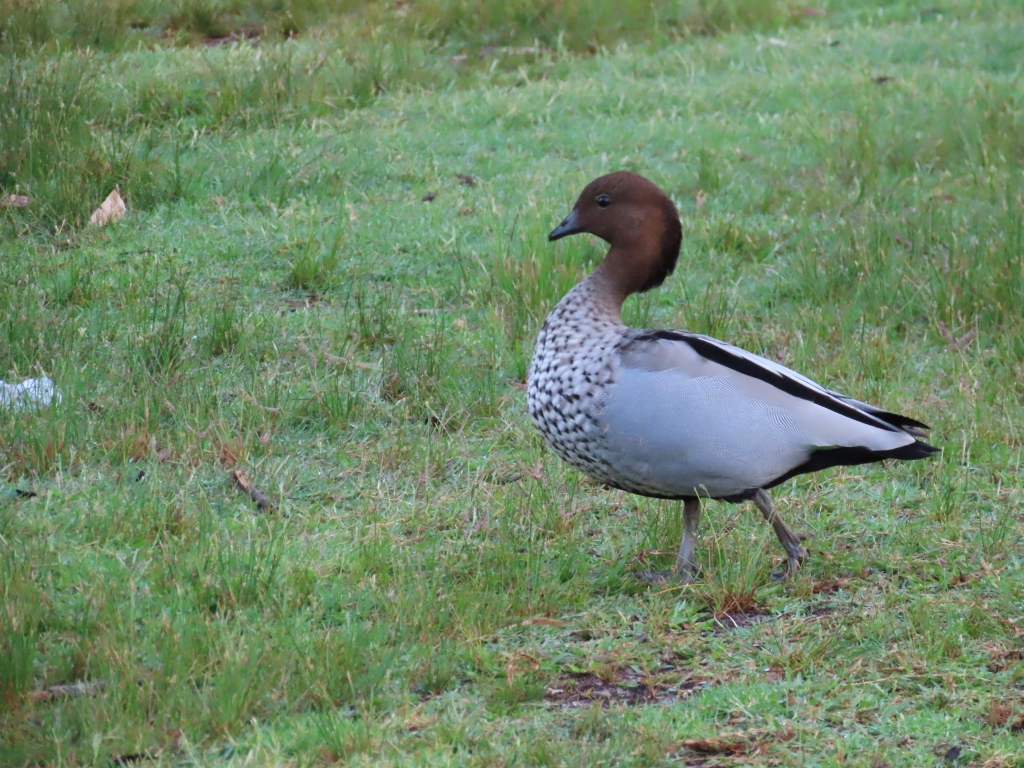
A female Australian Wood Duck:
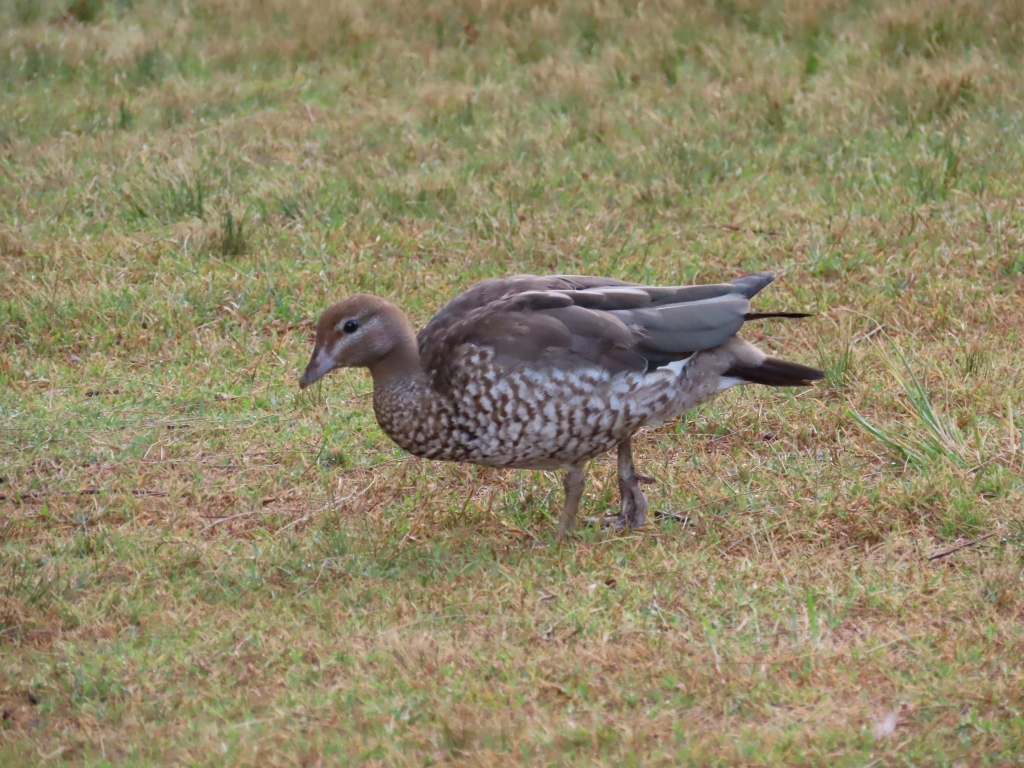
And a female Mallard with a gorgeous yellow-green beak:

For me as watcher, the meanderings of the ducks enhanced the quiet of the early morning scene.
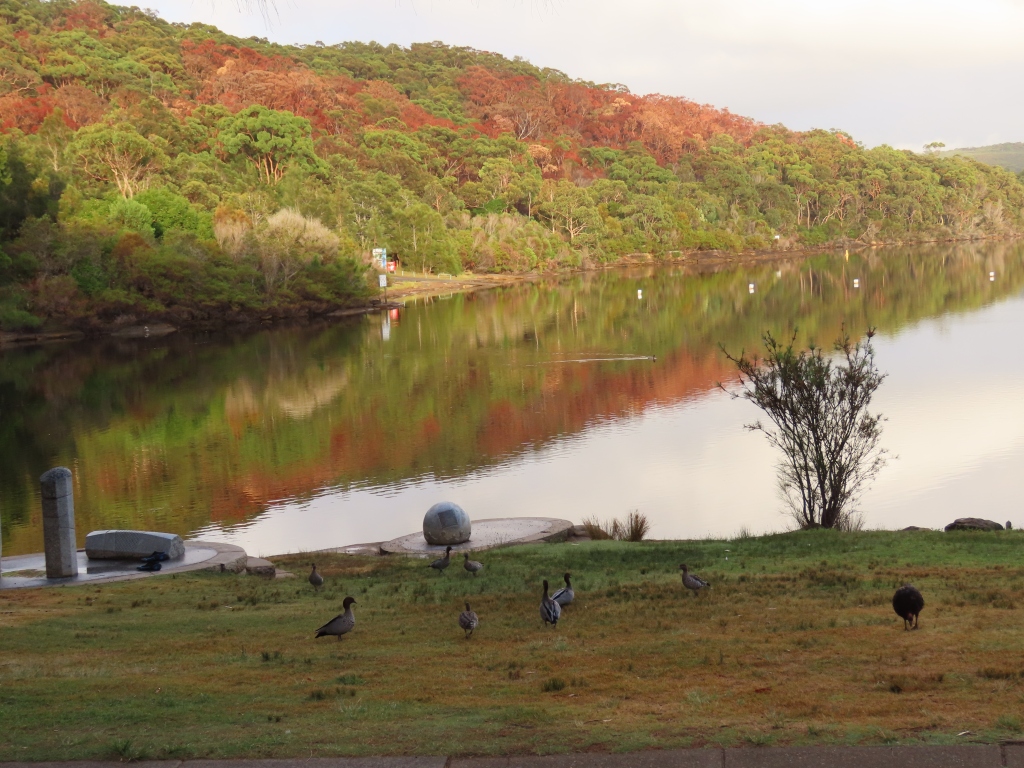
Oh yes, and there’s a Brush Turkey on the right too!
Birds from a boat on the Daintree River
In May this year I was lucky enough to visit Far North Queensland. While there, I took an early morning boat trip on the Daintree River (map). The tour, run by Ian “Sauce” Worcester, was called the Daintree River Wild Watch. Highly recommended!
The river is gorgeous in the early morning chill:
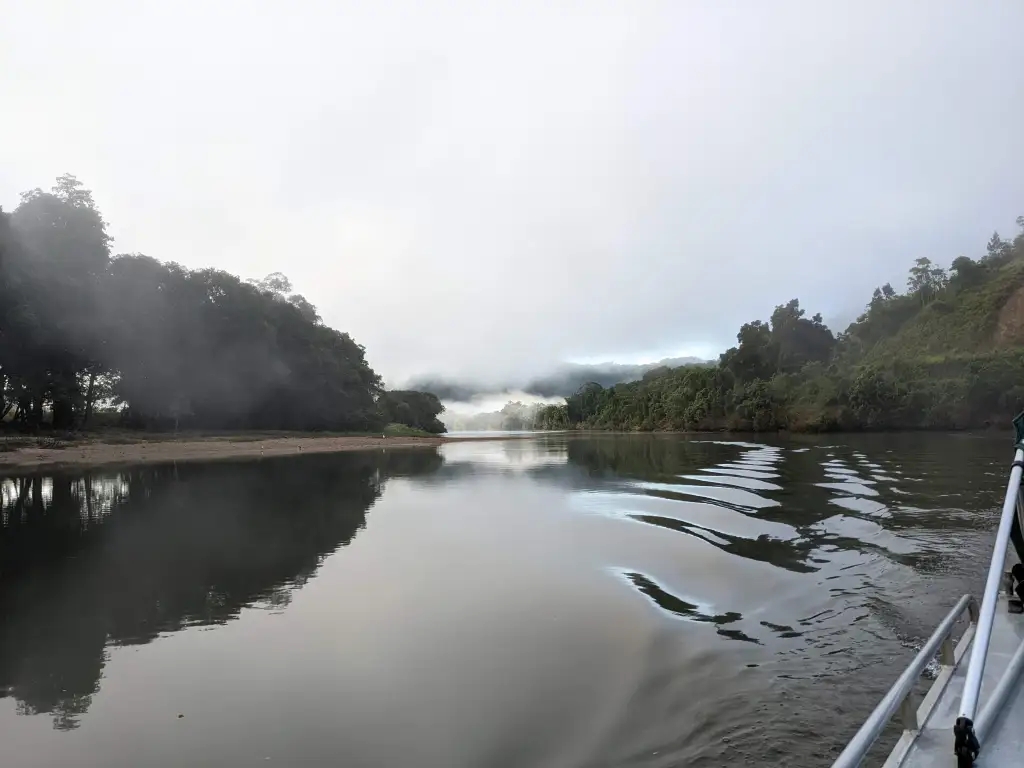
We saw a number of kingfishers on the banks of the river. This one is a Sacred Kingfisher:
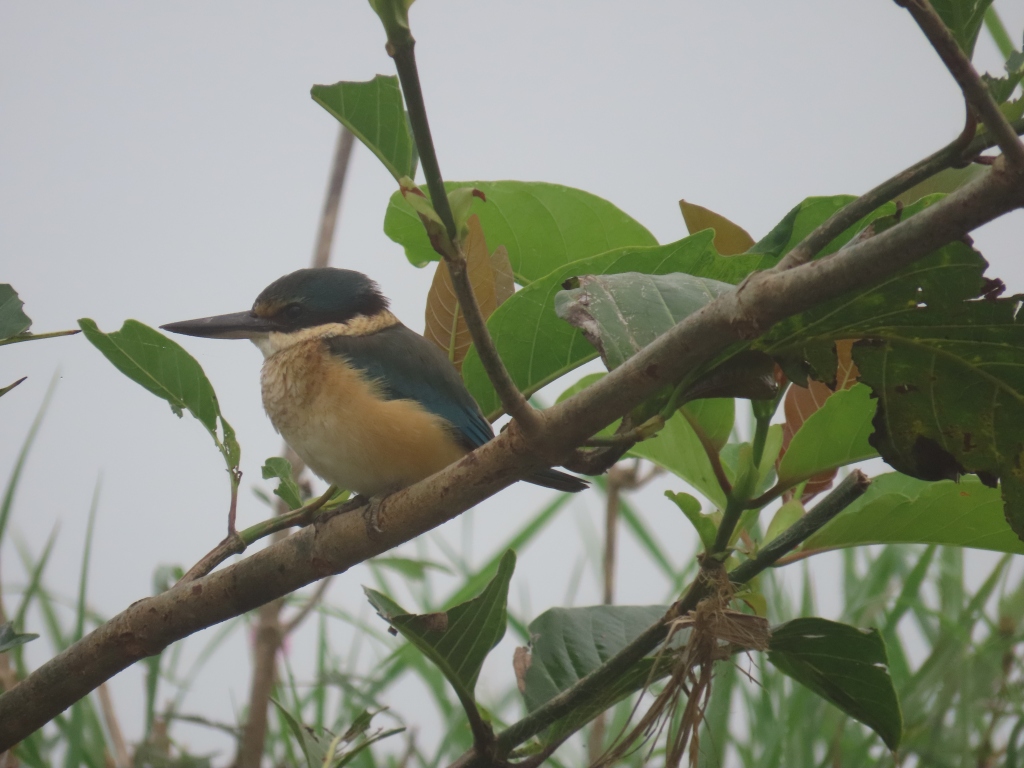
Another Sacred Kingfisher:

A Spectacled Monarch hid in the undergrowth of the mangrove forest. Our boat followed it quietly until it came into easy view:
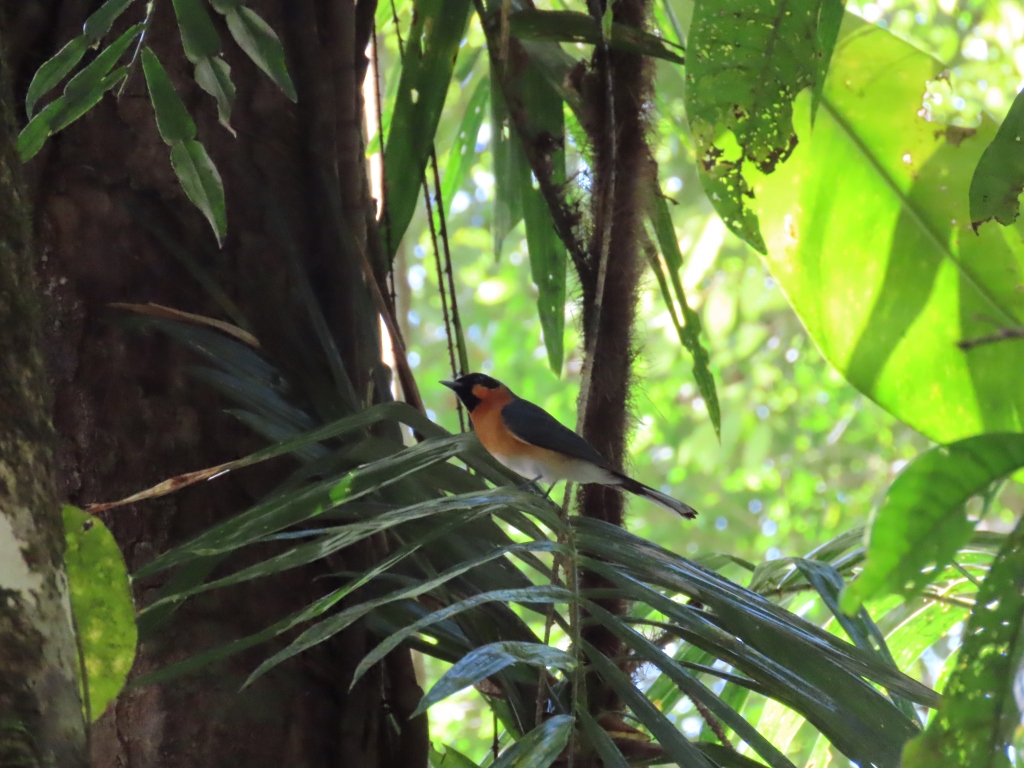
As the sun came up, a Rainbow Bee-eater landed on a high-up tree branch and fluffed out its feathers to take advantage of the warmth:
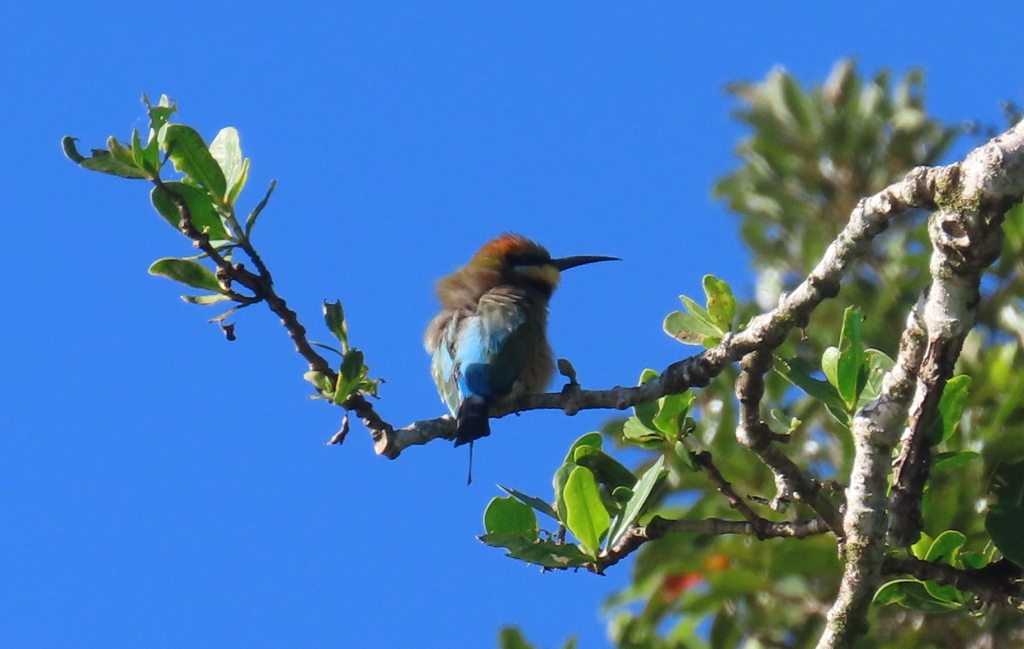
Here’s another view of the Rainbow Bee-eater:
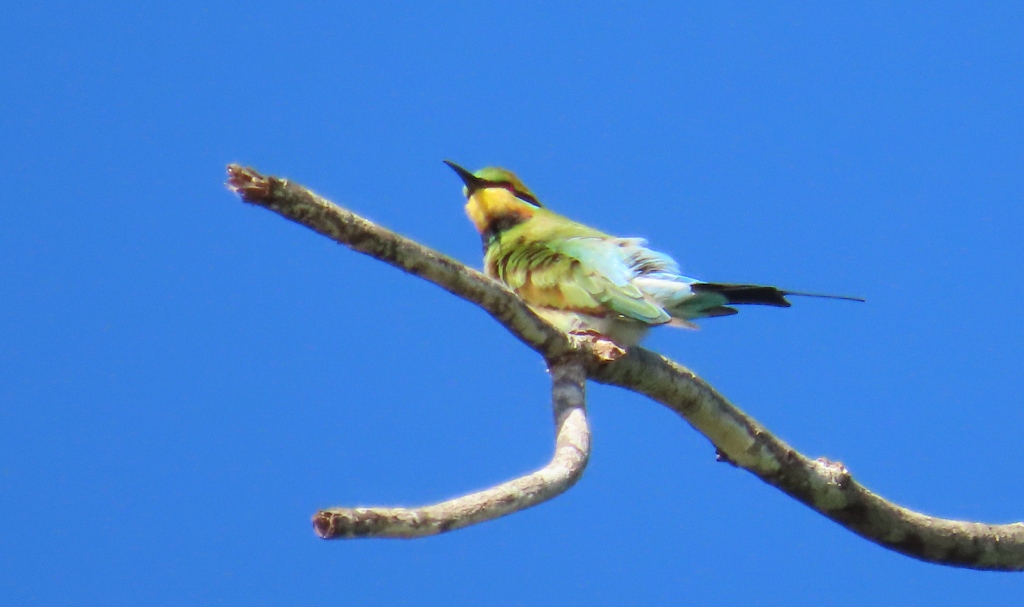
The river banks were at times covered in mangrove forests or fig trees. High above our heads, flowers bloomed:
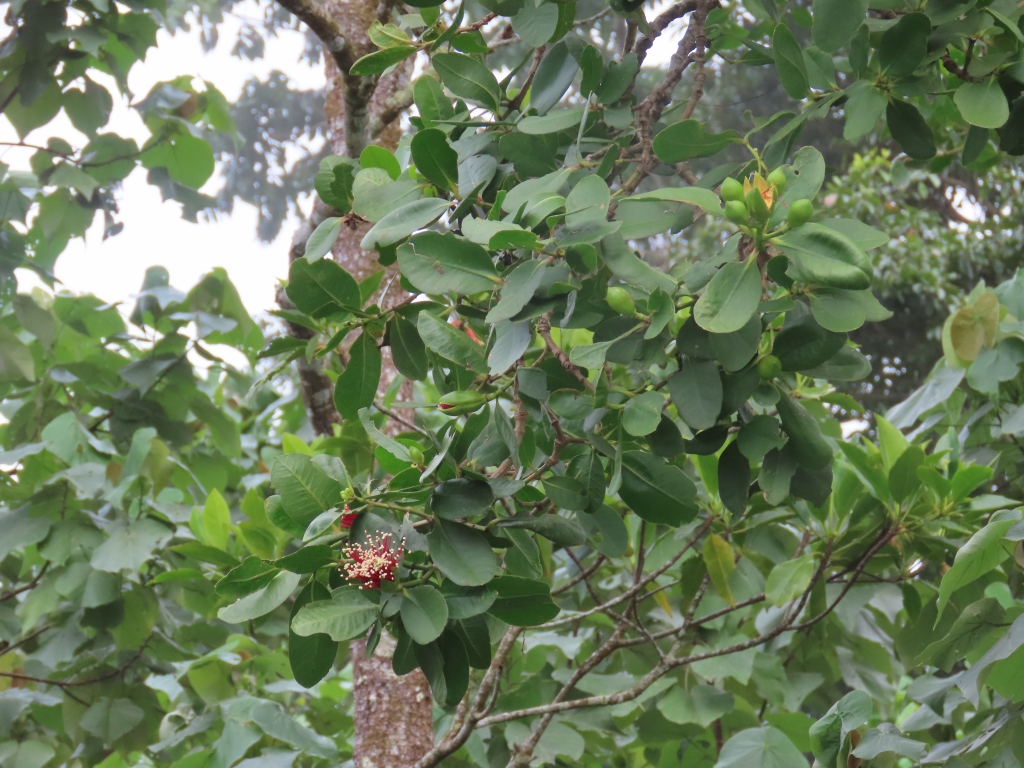
Waterbirds included these colourful Radjah Shelducks, sometimes called Burdekin ducks:

Another non-descript-looking duck caused some excitement, as our tour guide thought it might be a whistling duck but I can’t identify it. If anyone can say what it is, let me know:
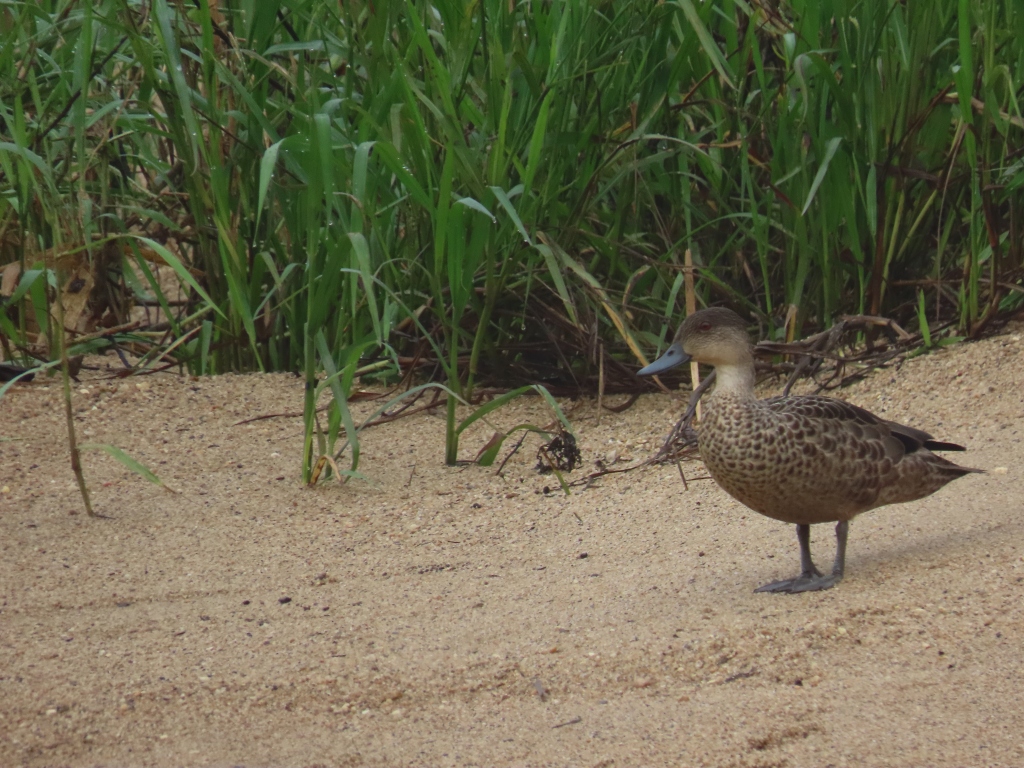
We saw a Darter roosting close to a Little Pied Cormorant. In this photo, the cormorant is behind the darter looking towards the right. The darter is in front, with its back to us, looking towards the left:
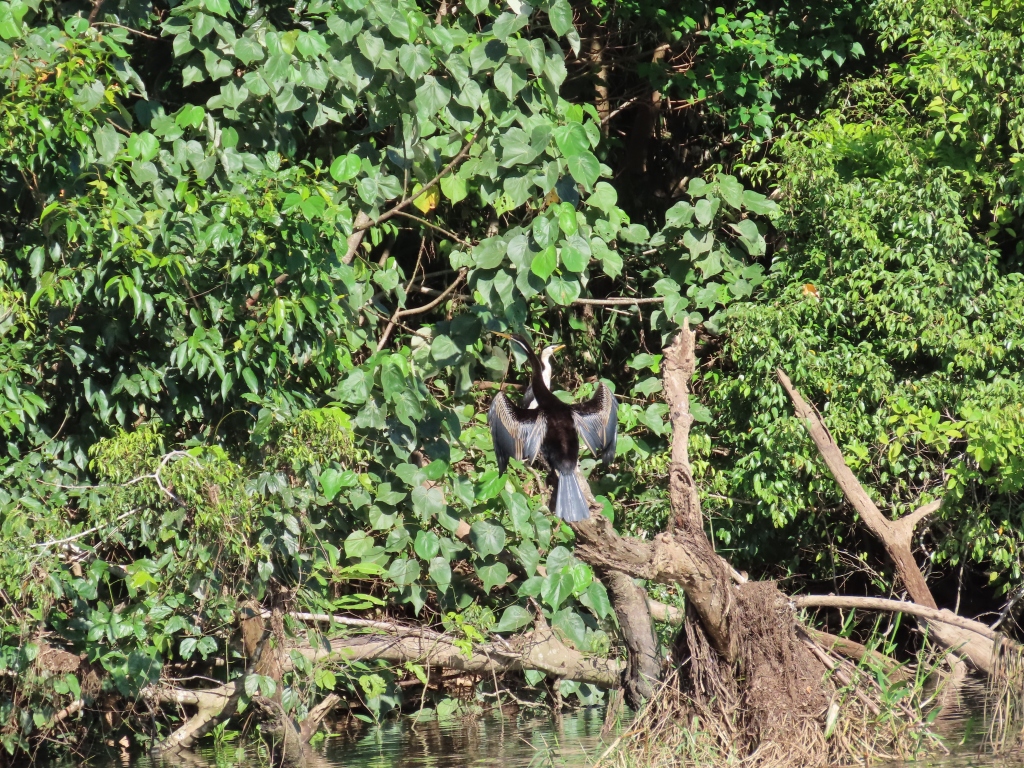
Three Little Pied Cormorants kept us company on the water. You can see the dense forest that covered much of the river bank:

An egret kept pace for a while too:
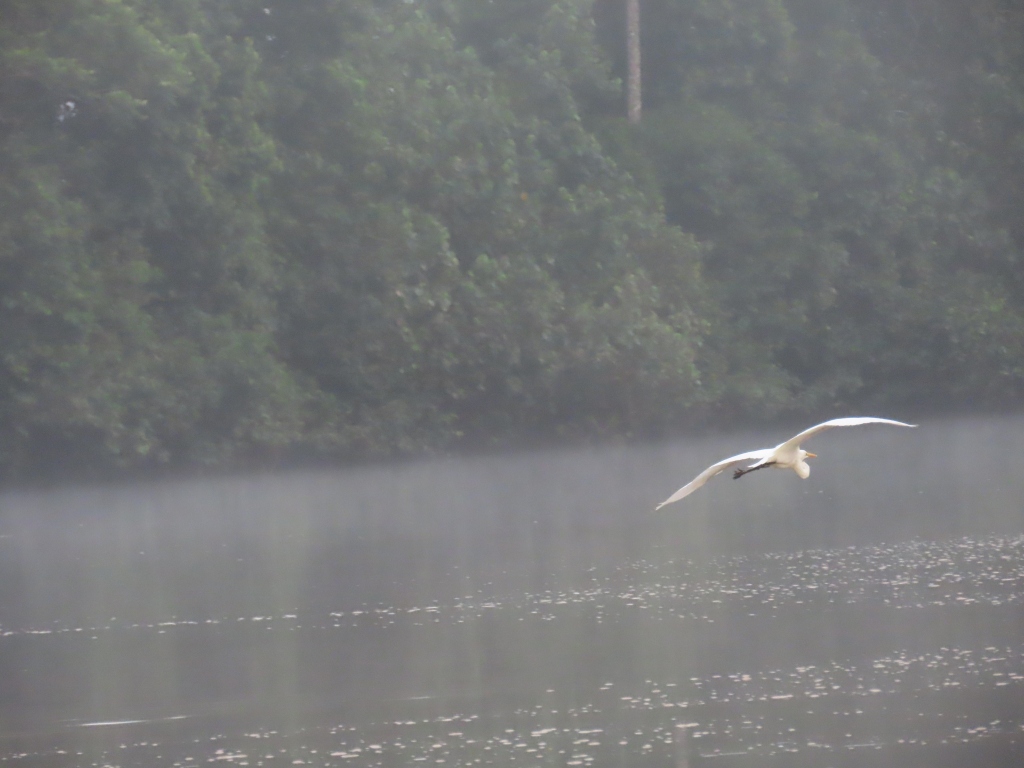
Baby black swans and ducklings
Baby swans are called cygnets. Pictures of cygnets from white swans are quite common, but what do baby black swans look like? Very similar to the white-swan babies, it turns out. They’re grey and fluffy, with black eyes, feet, and beak. I was delighted to spot a family of black swans while out walking a couple of days ago.

The parent swans were watchful, taking care to keep their little ones in a group. A male swan is called a cob, and a female is a pen. Five babies! That’s a lot of curiosity and cuteness to look after.

Did I say five babies? Yes. One of the cygnets was fossicking around in the undergrowth at the water’s edge. You can see the fifth little one in this video:
Common name: Black Swan
Scientific name: Cygnus atratus
Approximate length of adult: 120 cm
Date spotted: 9 October 2020 (spring)
Location: Manly Dam Park, New South Wales, Australia: 33°46’58.5″S 151°15’18.6″E
Nearby was a family of Australian Wood Ducks. The ducklings are almost as cute as the cygnets. But not quite!
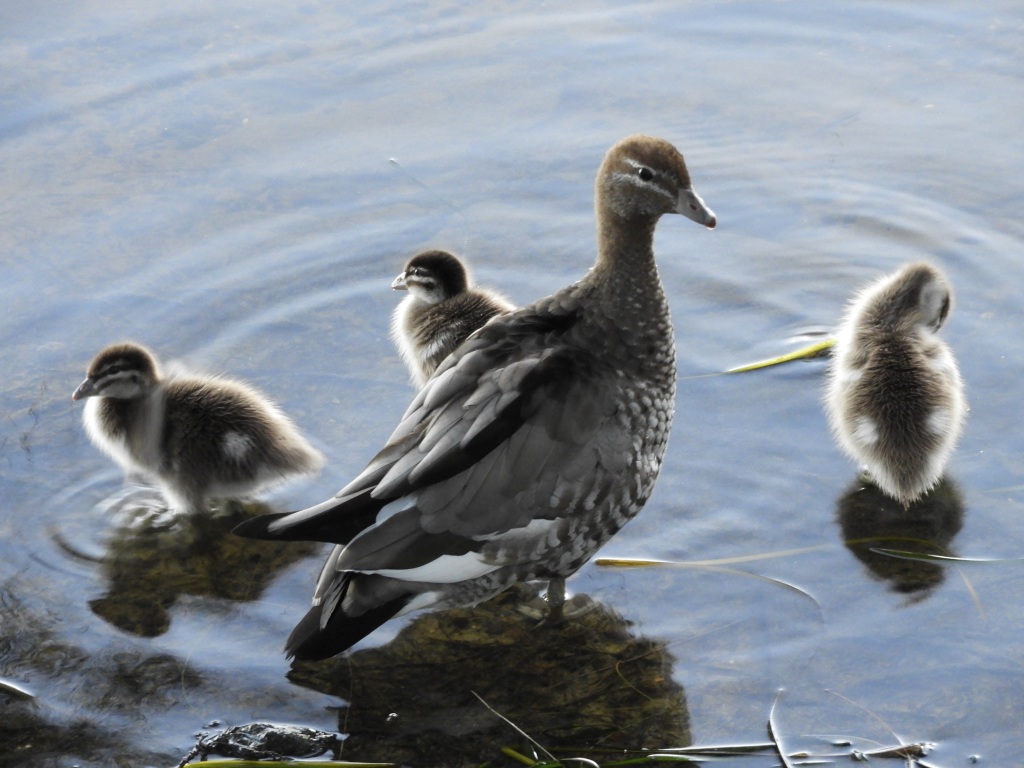
Common name: Australian Wood Duck
Scientific name: Chenonetta jubata
Approximate length of adult: 50 cm
Date spotted: 9 October 2020 (spring)
Location: Manly Dam Park, New South Wales, Australia: 33°46’58.5″S 151°15’18.6″E
Fluffy Australasian Grebe, not a duckling
Update on 19 April: The bird is actually an Australasian Grebe, not a duckling as I originally thought. Thanks to Pamela and Carol for helping to identify the bird (see comments on this post).
This tiny ball of fluff was zooming around an inlet of Manly Dam. I thought it was a Mallard duckling, because it seemed to spend most time close to an adult Mallard. Despite its size, the little thing was independent of spirit and a fast paddler.
Common name: Australasian Grebe
Scientific name: Tachybaptus novaehollandiae
Approximate length: 23-25 cm
Date spotted: 6 April 2020 (autumn)
Location: Manly Dam National Reserve, near Sydney: 33°46’34.8″S 151°14’49.6″E
This is the Mallard that the little one seemed to home in on:
Mallards are an introduced species in Australia. Their original home is the northern hemisphere, but they’re quite common in south eastern Australia now too.
Common name: Mallard
Scientific name: Anas Platyrhynchos
Approximate length: 50-70 cm
Date spotted: 6 April 2020 (autumn)
Location: Manly Dam National Reserve, near Sydney: 33°46’34.8″S 151°14’49.6″E
Australian Wood Duck
Australian Wood Ducks are a fairly common sight. They stand out, with their neat round head and short beaks. Up close, I noticed the soft frilly feathers on the sides of this bird’s body under the wings. This one is a male, as its head is dark brown and lacks the females’ white markings around the eyes.
Common name: Australian Wood Duck
Scientific name: Chenonetta jubata
Approximate length: 60cm
Date spotted: 3 June 2017 (Winter)
Location: Manly Dam Reserve, New South Wales, Australia: 33°46’58.1″S 151°15’14.7″E
Paradise Shelduck at Manly Dam, Australia
If this is a Paradise Shelduck, it’s rather far from its usual home in New Zealand. I spotted it at Manly Dam, near Sydney in Australia.
It’s a big duck. At first I wasn’t sure whether it was a duck or a goose. This one is a female, as you can tell from its white head and neck. The male has a dark head.
She took to the water:
And showed a bit of ankle:
Common name: Paradise Shelduck
Scientific name: Tadorna variegata
Approximate length: 63-70 cm
Date spotted: 26 November 2016
Season: Spring
Location: Manly Dam Reserve, New South Wales, Australia
Latitude/longitude: 33°46’58.0″S 151°15’18.9″E
Wood duck quacking high in a gum tree
For some reason I’ve never expected to see a duck high up a gum tree. I know they fly, but somehow I think of them as spending their lives on the ground or on the water. Walking through the bush, I’ve occasionally heard a muttering, rolling sound coming from the tree tops. Imagine my surprise when I tracked it down to this Australian Wood Duck.
Here’s a still photo of the duck:
And in profile:
Common name: Australian Wood Duck
Scientific name: Chenonetta jubata
Approximate length: 50 cm
Date spotted: 31 July 2016
Season: Winter
Location: Manly Dam Reserve, New South Wales, Australia
Latitude/longitude: 33°46’41.1″S 151°14’54.9″E
Swimming across the sky
Reflections at Manly Dam.
In the background you’ll hear Australian Ravens cawing, Wattlebirds croaking, and Whipbirds whistling.
Pacific Black Duck
Common name: Pacific Black Duck
Scientific name: Anas superciliosa
Approximate length: 45-60 cm
Date spotted: 25 December 2015
Season: Summer
Location: Manly Dam, New South Wales, Australia
Latitude/longitude: 33°46’55.0″S 151°15’19.7″E
Eurasian Coot
My bird book calls this coot dumpy. An interesting fact is that the coot has flattened toes rather than webbed feet for efficient swimming.
Common name: Eurasian Coot
Scientific name: Fulica atra
Approximate length: 35 cm
Date spotted: 25 December 2015
Season: Summer
Location: Manly Dam, New South Wales, Australia
Latitude/longitude: 33°46’55.0″S 151°15’19.7″E




